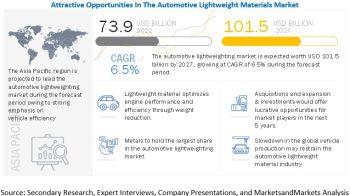
The global Automotive Head-up Display (HUD) Market is projected to reach $3.9 billion by 2027 from $1.0 billion in 2022, at a CAGR of 30.4% during the forecast period. The market is driven by increased customer awareness about road and vehicle safety, demand for improved consumer experience in vehicles, and high growth in the luxury and high-end cars segments, mainly in the emerging markets.
A head-up display ensures that the driver can access all the required information on the windshield at eye level. As a result, the driver’s focus remains on the road at all times and is not distracted by the various in-vehicle displays that provide information. The head-up display is being adopted widely across vehicle segments. The augmented reality head-up display projects the same information in the driver’s field of view, certain feet away from the vehicle. There is a great demand for HUD that enhances the user experience with new ways of displaying visual information without causing a distraction to the driver. The growing demand and the increasing competition among OEMs have resulted in reduced prices of display panels such as LCD and TFT-LCD display panels, HUDs (heads-up displays), smaller displays, and hybrid and digital instruments clusters, among others. Further, there have been advancements being carried out in automotive cockpit electronics technology such as AR head-up displays, advanced gesture controls, and haptic feedback. Most ultra-premium and advanced vehicles have two or more unique displays to provide divergent information such as Heating, Ventilation and Air Conditioning (HVAC), parking guidance, infotainment, vehicle diagnostics, and so on.
Some of the leading manufacturers and suppliers of the automotive HUD market are Bosch (Germany), Continental (Germany), Denso (Japan), Visteon (US), Nippon Seiki (Japan), Panasonic (Japan), Pioneer (Japan), Yazaki (Japan), and others.
Download PDF Brochure @ https://www.marketsandmarkets.com/pdfdownloadNew.asp?id=11272971
The automotive HUD market in Europe is estimated to be the largest in the year 2022, by value. The market growth in the region can be attributed to the high luxury vehicle production capabilities coupled with the presence of leading HUD manufacturers such as Bosch and Continental. Further, increasing purchasing power and high demand for luxury and convenience features will propel the growth of the market in this region. The European HUD market is projected to grow from USD 395 million in 2022 to
USD 1,309 million by 2027. Increased production levels of automobiles, high adoption of advanced technologies in automotive electronics, and rapid progress of semi-autonomous and autonomous vehicles are also expected to boost the demand for automotive HUD in this region.
The windshield HUD segment is estimated to hold the largest market share during the forecast period owing to its preference by OEMs. In addition, this type of HUD integrates multiple functions, provides higher resolution and better visuals, and can also be used for augmented reality HUD. However, the price of the windshield HUD is higher than that of the combiner HUD. Combiner HUDs are preferred in mid-segment vehicles because of their cost-effectiveness and offer cost-effective systems with a compact field of view and limited colour definition. The combiner HUD segment is projected to grow at the highest CAGR of 44.1% during the forecasted period.
The luxury car segment is estimated to be the largest segment of the automotive HUD market during the forecast period. This segment is estimated to reach USD 1,126 million by 2027. The leading vehicle manufacturers introduced their innovative and advanced features in this segment to stand out from the rest, which eventually fuels the growth of this segment. The mid-segment car market is projected to register the fastest growth. The growth of this segment can be attributed to the use of combiner HUDs, which provide enhanced optical quality and increased brightness on a smaller display placed on the dashboard. This technology helps to meet compact space requirements, which in turn increases its adoption by OEMs.
Request FREE Sample Report @ https://www.marketsandmarkets.com/requestsampleNew.asp?id=11272971
Opportunity: Introduction of portable HUDs at lower prices in low and middle car segments
Technological advancements are driving the automotive industry to the next level. Features such as driver assists and surround-view cameras that were once available exclusively in luxury vehicles now come as a standard even in some economy cars. The same thing is slowly happening with head-up displays (HUD). For example, the 10-inch HUD in the 2018 Toyota Camry is one of the largest and best HUDs used in any car.
Mazda is another mainstream brand that offers HUDs in several of its vehicles. But instead of embedding expensive components in the dash and using a special windshield, the HUDs in the Mazda3 and Mazda6 use a thin plastic lens that folds down when not in use. MINI has a similar solution, but this low-cost approach has limits in terms of size and position of the images compared to traditional HUDs that use the windshield as a screen.

